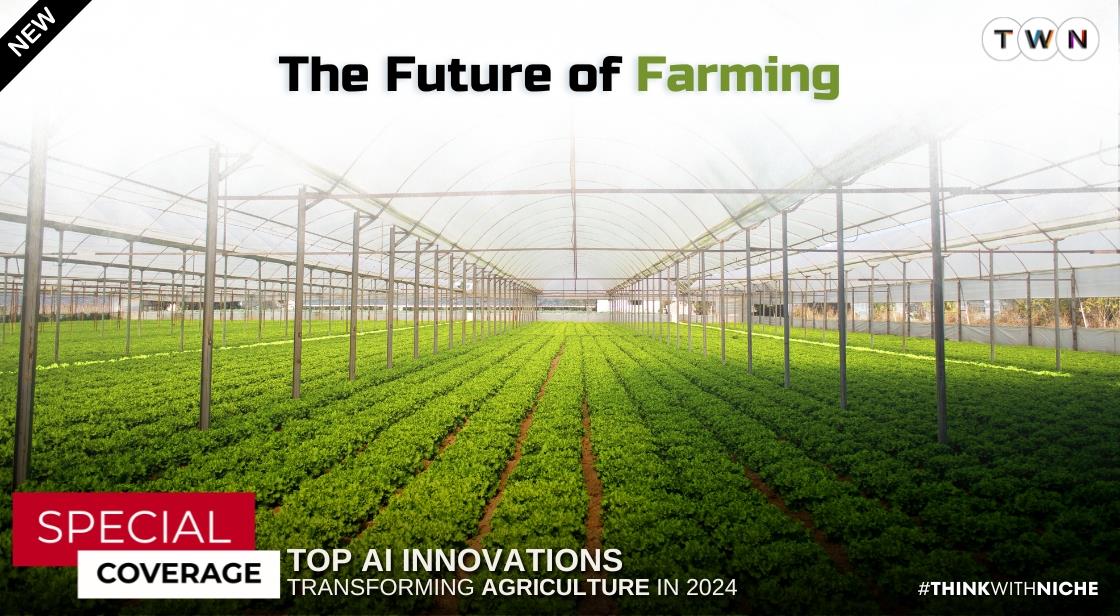Top AI Innovations Transforming Agriculture in 2024: The Future of Farming is Here

Blog Post
In 2024, the agriculture sector stands on the cusp of a groundbreaking revolution, propelled by the ever-evolving advancements in artificial intelligence (AI).
The fusion of AI technologies with traditional farming methods promises to redefine the future of agriculture, addressing critical challenges and optimizing yields with unprecedented precision.
Recent projections indicate a remarkable surge in AI-driven agricultural innovations, spearheading a transformative shift in how we cultivate crops, manage resources, and ensure global food security.
According to recent studies, the global AI in agriculture market is expected to grow substantially, reaching an estimated value of over $6.9 billion by 2024.
This staggering growth trajectory underscores the increasing recognition and adoption of AI-powered solutions in revolutionizing farming practices worldwide.
Moreover, AI's role in agriculture has transcended theoretical concepts, manifesting in tangible innovations that promise to reshape the landscape of farming.
From robotic farming assistants and predictive analytics to sustainable resource management tools, 2024 heralds a new era where intelligent technologies take the helm in optimizing every aspect of agricultural production.
With an emphasis on real-world applications and innovative startups driving this revolution, this exploration aims to unravel the top AI-driven innovations poised to transform agriculture in 2024.
These advancements promise not only enhanced productivity and efficiency but also sustainable practices that mitigate environmental impact, ensuring a more resilient and prosperous future for the agricultural domain.
Top AI InnovationsTransforming Agriculture in 2024: The Future of Farming is Here
Robotically-Assisted Farming: Where Precision Meets Automation
The vision of robots diligently working alongside farmers is quickly becoming a reality. 2024 promises significant advancements in robotic technology, revolutionizing the way we cultivate crops and manage large-scale agricultural operations.
Let's delve deeper into the exciting world of robotically-assisted farming, exploring new players and groundbreaking innovations:
Smart Weeders and Planters:
Beyond the mere promise, companies like Naïo Technologies and EarthSense are delivering. Their robots, equipped with AI-powered vision systems, can navigate fields autonomously, identify and eliminate weeds with laser precision, and plant seeds at optimal spacing. This not only reduces labor costs and herbicide use but also minimizes soil erosion, paving the way for sustainable farming practices.
Autonomous Tractors and Harvesters:
The self-driving future is arriving in fields too. John Deere's 8R tractor is just the tip of the iceberg. These AI-powered behemoths can cultivate land with remarkable accuracy, optimizing fuel consumption and reducing human fatigue. But the robots won't stop there.
Expect to see significant advancements in harvesting robots in 2024, with gentle robotic arms capable of handling delicate fruits and vegetables like strawberries and tomatoes with minimal damage.
Beyond the Giants: Startups Pushing the Boundaries:
Several innovative startups are vying for a piece of the burgeoning robotic farming market, each offering unique solutions:
Advanced.Farm (US):
-
This American startup isn't just focusing on weeding or planting. Their robots tackle the entire harvesting process, using stereo cameras to identify and pick ripe produce based on size and color. Food-safe grippers ensure gentle handling, while autonomous tractors and hybrid-electric drive systems complete the autonomous farming ecosystem, saving farmers time and resources.
Nexus Robotics (Canada):
-
Meet Le Chevre, the weed-whacking robot from Canada. Utilizing deep learning algorithms and advanced cameras, Le Chevre accurately distinguishes between weeds and crops, removing the unwanted invaders without harming the precious produce. But its capabilities don't stop there. Le Chevre also collects valuable data on crop health and growing conditions, empowering farmers with data-driven insights to optimize their operations.
The Future of Farming is Robotic:
These are just a few examples of the robotic revolution sweeping across agriculture. As AI and robotics technologies continue to evolve, we can expect even more sophisticated robots capable of performing a wider range of tasks, from planting and harvesting to monitoring crop health and managing livestock.
This robotic renaissance will not only address the challenges of labor shortages and resource constraints but also usher in a new era of precision farming, maximizing yields, minimizing environmental impact, and ensuring food security for a growing population.
AI-Powered Predictive Analytics: From Weather Whispers to Yield Wisdom
Gone are the days of relying on distant weather reports and gut instincts for crucial farm decisions. 2024 marks the rise of AI-powered predictive analytics, transforming farming from a gamble into a data-driven science.
Let's explore how these groundbreaking platforms are whispering secrets of future weather and crop health, empowering farmers to optimize resources and maximize yields:
Hyperlocal Weather: Whispers on the Wind:
Traditionally, broad weather forecasts were about as helpful as a one-size-fits-all jacket in a diverse world. But AI platforms like DeepWeather and Phytech are changing the game.
They leverage hyperlocal data from satellites, weather stations, and even farm-based sensors to paint a hyperprecise picture of upcoming weather conditions, specific to each field. This empowers farmers to:
-
Optimize irrigation: By anticipating localized downpours and dry spells, farmers can ensure their crops receive just the right amount of water, reducing waste and boosting efficiency.
-
Plan pest control: Advance knowledge of humidity and wind patterns allows proactive spraying schedules, protecting crops from disease and pests before they spread.
-
Time harvests perfectly: Accurate predictions of hailstorms or frost enable farmers to harvest at the peak of ripeness, minimizing losses and maximizing market value.
Yield Prophecies: From Data to Abundant Harvests:
AI isn't just whispering weather secrets; it's reading the future of your crops. Platforms like Prospera and Taranis analyze a symphony of data from drones, satellites, and ground sensors.
This includes imagery that reveals subtle changes in plant health, soil moisture levels, and nutrient deficiencies. With this information, AI algorithms predict:
-
Crop yields with uncanny accuracy: Knowing the expected harvest weeks in advance allows farmers to plan logistics, negotiate contracts, and allocate resources more effectively.
-
Potential disease outbreaks: By identifying early signs of stress or nutrient imbalances, AI can anticipate potential pest and disease issues, enabling farmers to take preventative measures before they devastate crops.
-
The need for specific interventions: Analyzing data from individual plants within a field, AI can pinpoint areas requiring targeted fertilizer application, weed control, or even specialized treatment, optimizing resource allocation and minimizing waste.
Real-World Examples: Whispers Bearing Fruit:
These aren't mere theoretical possibilities. Farmers worldwide are reaping the benefits of AI-powered predictive analytics:
-
In California's Central Valley, a walnut farmer used hyperlocal weather forecasting from DeepWeather to anticipate a sudden hailstorm, saving his entire crop by initiating harvest just hours before the downpour.
-
An apple orchard in Michigan utilized Prospera's AI-driven disease prediction to identify a developing fungal outbreak in a specific section of the orchard. Early fungicide application prevented the disease from spreading, saving thousands of trees and tons of fruit.
Sustainable Resource Management: Cultivating Abundance with AI-Powered Efficiency
In an era of climate change and resource scarcity, the future of agriculture hinges on maximizing output while minimizing impact. Thankfully, AI is stepping up to the challenge, empowering farmers to become environmental stewards by optimizing resource management.
Let's delve into the innovative tools and real-world success stories driving this sustainable revolution:
Precision Irrigation: Watering Wisdom from Data:
Gone are the days of blanket irrigation, leaving thirsty crops and overflowing rivers in their wake. AI-powered irrigation systems like those from Netafim and CropX are ushering in an era of water wisdom.
These smart systems utilize a symphony of sensors, weather data, and plant health algorithms to:
-
Monitor soil moisture in real-time: Precise sensors embedded in fields send continuous data about soil moisture levels, ensuring targeted watering only where and when needed.
-
Predict weather patterns: Advanced AI algorithms integrate weather forecasts with local conditions to anticipate droughts and adjust irrigation schedules accordingly, preventing overwatering during rain events.
-
Optimize water delivery: Drip irrigation systems coupled with AI intelligence deliver water directly to plant roots, minimizing evaporation and maximizing efficiency.
Real-World Impact: Quenching Thirsty Fields:
-
A Californian avocado farmer utilizing CropX's AI irrigation system reduced water usage by 25% while simultaneously boosting yields by 10%, proving that sustainability and profitability can go hand-in-hand.
-
A rice cooperative in India partnered with Netafim to implement AI-powered irrigation, leading to a 30% decrease in water consumption and a significant rise in farmer income, showcasing the transformative power of technology in resource-scarce regions.
Waste Reduction and Nutrient Optimization: From Leftovers to Lush Fields:
AI isn't just about water; it's about maximizing every resource. Platforms like AgTech and Arable analyze farm data to identify inefficiencies and propose solutions for minimizing waste in:
-
Fertilizer application: By pinpointing areas of nutrient deficiency and tailoring fertilizer application accordingly, AI helps farmers avoid over-fertilization, reducing water pollution and boosting crop health.
-
Energy consumption: AI algorithms analyze farm equipment usage and suggest optimization strategies, such as scheduling tasks during peak solar hours for solar-powered machinery, leading to significant energy savings.
-
Food waste: AI-powered sorting systems can identify and remove imperfect produce before they reach the market, minimizing food waste and maximizing overall yield.
Real-World Success: Turning Leftovers into Abundance:
-
A dairy farm in the Netherlands partnered with AgTech to implement AI-driven feed optimization, reducing their feed waste by 15% and improving milk production by 5%, demonstrating the potential of AI to boost both environmental and economic efficiency.
-
An apple orchard in Washington State adopted Arable's AI-powered sorting system, leading to a 20% reduction in post-harvest food waste and increased revenue from selling previously discarded fruits, exemplifying the power of technology to combat food insecurity.
How Agri-Drones Are Transforming Farms
Unmanned aerial vehicles (UAVs), better known as drones, are no longer just buzzworthy toys. In the hands of innovative farmers, they're becoming indispensable tools for precision agriculture, offering a bird's-eye view of vast fields and transforming raw data into actionable insights.
Let's explore how these airborne marvels are revolutionizing farm management:
Revolutionizing Precision Farming:
Eyes in the Sky: Drones equipped with high-resolution cameras capture detailed aerial imagery, from standard photographs to multispectral images revealing hidden patterns in crop health, soil composition, and pest infestations. This data powers precision agriculture, enabling farmers to:
-
Target fertilizer and pesticide application: pinpoint areas requiring specific attention, minimizing waste and environmental impact.
-
Optimize irrigation: map soil moisture levels and tailor water usage to each field section, preventing overwatering and conserving precious resources.
-
Monitor crop growth: track vegetation patterns across the field, identifying areas of stress or stunted growth to address potential issues early on.
Beyond Precision:
Drones offer a diverse range of functionalities beyond precision agriculture:
-
Streamlined Livestock Management: Drones can track grazing animals, ensuring their safety and optimizing pasture utilization. They can also help monitor for stray animals and potential threats like predators.
-
Enhanced Efficiency: Drones expedite time-consuming tasks like field surveying, boundary mapping, and crop damage assessment, freeing up valuable time for farmers to focus on other critical tasks.
-
Advanced Data Collection: Equipped with specialized sensors, drones can measure chlorophyll levels, assess weed pressure, and even analyze soil mineral and chemical composition, providing invaluable data for informed decision-making.
Meet the Drone Pioneers:
Several innovative startups are leading the charge in agri-drone technology:
-
This enterprising startup uses drones to revolutionize date palm pollination, traditionally a labor-intensive and time-consuming process. Their drones equipped with AI and computer vision can target individual trees efficiently, maximizing pollination success and boosting crop yields.
Equinox's Drones (India):
-
This pioneering startup offers a comprehensive suite of drone-powered services, including crop surveillance, aerial inspection, data processing, and yield estimation. Their advanced data analysis platform helps farmers track crop health, identify problem areas, and optimize resource allocation.
The Future of Farming Takes Flight:
The capabilities of agri-drones are constantly evolving, with advancements in AI, automation, and sensor technology pushing the boundaries of what's possible. As drone technology becomes more accessible and affordable, we can expect even wider adoption by farmers, leading to a future where intelligent data-driven practices optimize yield, minimize waste, and ensure food security for a growing population.
You May Like
EDITOR’S CHOICE












